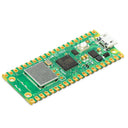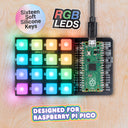Raspberry Pi Pico W
by Raspberry Pi



A low cost, flexible microcontroller board with wireless, built around Raspberry Pi's RP2040 chip.
Raspberry Pi Pico W is Raspberry Pi's first wireless microcontroller board, designed especially for physical computing. Microcontrollers are a different type of device than Single Board Computers (like the Raspberry Pi 4 and previous generations of Pi), they don't run an operating system and they are typically programmed to do just one task - though that task can be pretty intricate and exciting! They're perfect for experimenting with hardware and using as the brains of custom devices, machines and inventions. With the onboard 2.4GHz wireless capabilities of the Pico W, it's now possible for your creations to talk to each other, and to the internet!
Apart from the addition of wireless networking, Raspberry Pi Pico W is very similar to Raspberry Pi Pico and, like all RP2040-based boards, can be easily reprogrammed over USB from a Raspberry Pi or other computer using the C/C++ SDK or the official MicroPython port. The documentation landing page is the best place to get started, or scroll down for links to the technical documentation for both the Raspberry Pi Pico W microcontroller board and the RP2040 microcontroller chip.
As standard, Raspberry Pi Pico W comes without header pins so you'll need to pick some up separately if you're planning on plugging your Pico into into a breadboard or one of our Pico add-ons. Alternatively, you can now pick up a Raspberry Pi Pico WH which comes with pre-soldered headers, and a convenient connector for solderless software debugging.
Board Specifications
Raspberry Pi Pico W has been designed to be a low cost yet flexible development platform for RP2040, with a 2.4GHz wireless interface and the following key features:
- RP2040 microcontroller chip designed by Raspberry Pi in the United Kingdom
- Dual-core ARM Cortex M0+ processor, flexible clock running up to 133 MHz
- 264kB of SRAM, and 2MB of on-board Flash memory
- On-board single-band 2.4GHz wireless interfaces (802.11n)
- Castellated module allows soldering direct to carrier boards
- USB 1.1 Host and Device support
- Low-power sleep and dormant modes
- Drag & drop programming using mass storage over USB
- 26 multi-function GPIO pins
- 2×SPI, 2×I2C, 2×UART, 3×12-bit ADC, 16×controllable PWM channels
- Accurate clock and timer on-chip
- Temperature sensor
- Accelerated floating point libraries on-chip
- 8×Programmable IO (PIO) state machines for custom peripheral support
Raspberry Pi Pico W and Pico WH incorporate an Infineon CYW43439 wireless chip. CYW43439 supports IEEE 802.11 b/g/n wireless LAN, and Bluetooth 5.2.
Documentation
All documentation for the Raspberry Pi Pico W board and the RP2040 microcontroller can be found through the documentation landing page.
-
Raspberry Pi Pico W Datasheet - An RP2040-based microcontroller board with wireless
- Raspberry Pi Pico W Pinout
- Connecting to the Internet with Raspberry Pi Pico W
-
RP2040 Datasheet - A microcontroller by Raspberry Pi
- Hardware design with the RP2040 - Using the RP2040 microcontroller to build boards and products
- Getting Started with Raspberry Pi Pico - C/C++ development with the Pico and other RP2040-based microcontroller boards
- Pico C/C++ SDK - Libraries and tools for C/C++ development on the RP2040 microcontroller
- Pico Python SDK - A MicroPython environment for the RP2040 microcontroller
The API level Doxygen documentation for the Raspberry Pi Pico C/C++ SDK is available as a micro-site.
Pinout
There's a handy interactive pinout for Raspberry Pi Pico at pico.pinout.xyz.
Dimensions
Dimensions: 21mm(W) x 51.3mm(L) x 3.9mm(H)
-
Without Headers
SC0918£4.83 -
With Headers
SC0919£5.67
Great addons to go with your Pico / compatible board
Add features like displays, audio and more!
-
 Pico Enviro+ Pack+ £37.50
Pico Enviro+ Pack+ £37.50 -
 Pico GFX Pack+ £13.75
Pico GFX Pack+ £13.75
Turn your Pico into something else with a Base
Build your project around these fully featured host boards.
-
 Pico RGB Keypad Base+ £18.25
Pico RGB Keypad Base+ £18.25
Shop with confidence – we've been serving the hobbyist electronics, Maker, and retro gaming communities since 2012.
- Satisfaction or refund guarantee
- Worldwide shipping via mail or courier
- 57,000+ customer reviews
- Approved Raspberry Pi Reseller
- Secure website and payments




